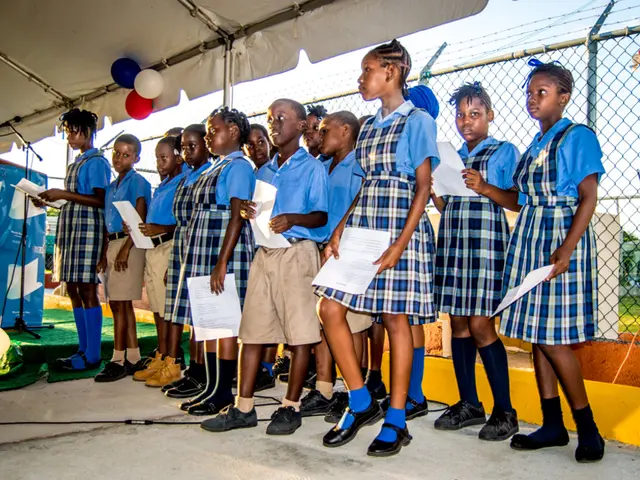Care Provision a Legitimate Profession?
In the United States, more than 11 million individuals are engaged in informal caregiving, providing nearly 18 billion hours of unpaid care annually, primarily to older adults or those with chronic conditions [1][2]. This vast army of unpaid caregivers represents a substantial portion of the population, with 16.8% of the U.S. population acting as informal caregivers for people aged 50 or older [2].
These caregivers, often sons, daughters, spouses, or friends, do not require a college degree to provide care. Instead, they bring a personal touch and a unique bond to their caregiving roles [3]. Like their professional counterparts, informal caregivers need certain traits, such as being calm, caring, and understanding [3].
The demographic landscape of caregiving is changing, with a 20% decline in U.S. birth rates since 2007 reducing the supply of family caregivers [5]. This shift puts pressure on informal caregiving systems, leading to significant caregiver burdens, including physical and mental health declines, social isolation, burnout, and financial strain [4][5]. Informal caregivers, who often provide 28.6 hours of care per week for cancer patients alone, incur significant hidden economic burdens, with an estimated informal care cost of around $60,853 per caregiver [3].
Financial arrangements typically do not compensate informal caregivers, leading to these significant hidden economic burdens. While Medicaid and other programs exist, they face limitations and variability across states. The caregiving landscape is further complicated by the closure of many nursing homes and challenges in formal care services, heightening reliance on informal caregiving while limiting access to affordable and quality support services [5].
Interestingly, a 2020 survey by the American Association of Retired Persons (AARP) revealed a rise in young (18-45 years) caregivers in the U.S. [6]. These young caregivers can learn about the tasks and responsibilities involved in caring for an elderly family member through the internet. However, about 27% of caregivers report difficulty accessing affordable services [5].
State-level reforms aim to address workforce shortages by offering wage incentives, training requirements, and tiered reimbursement rates, but these are uneven across the country and primarily target formal care sectors, not informal caregivers specifically [5].
On the other hand, professional caregivers undergo formal training and may hold certifications such as Personal Care Assistant (PCA), Home Health Aide (HHA), Patient Care Assistant (PCA), National Caregiver Certification Course (NCCC), National Assisted Living Manager Certification (NALMCC), and Certified Nursing Assistant (CNA) [3].
Despite the differences between informal and formal caregiving, the level of difficulty in caring for an aging family member and caring for a client with dementia is similar. In some cases, a small percentage of participants share the responsibility of caregiving with other family members [3].
In conclusion, informal caregiving in the U.S. is extensive and essential but faces demographic challenges, increasing caregiver burden, significant financial costs to caregivers without direct compensation, and limited access to formal support. State-level reforms aim to address workforce shortages but do not fully alleviate informal caregivers' hardships [1][2][3][4][5].
References:
[1] Family Caregiver Alliance. (n.d.). National Centre on Caregiving. Retrieved from https://www.caregiver.org/
[2] National Alliance for Caregiving & AARP Public Policy Institute. (2015). Caregiving in the U.S. 2015. Retrieved from https://www.aarp.org/content/dam/aarp/ppi/2015/caregiving-in-the-us-2015-report.doi.10.26419-2Fppi.00046.001.pdf
[3] National Alliance for Caregiving & AARP Public Policy Institute. (2020). Caregiving in the U.S. 2020. Retrieved from https://www.aarp.org/content/dam/aarp/ppi/2020/caregiving-in-the-u-s-2020-report.doi.10.26419-2Fppi.00081.001.pdf
[4] National Academies of Sciences, Engineering, and Medicine. (2020). Families Caring for an Aging America. Retrieved from https://www.nap.edu/read/25723/chapter/1
[5] National Academy of Medicine. (2020). Dementia Care: Transforming the System. Retrieved from https://nam.edu/wp-content/uploads/2020/02/DementiaCare_TransformingtheSystem.pdf
[6] AARP. (2020). Caregiving in the U.S. 2020. Retrieved from https://www.aarp.org/content/dam/aarp/ppi/2020/caregiving-in-the-u-s-2020-report.doi.10.26419-2Fppi.00081.001.pdf
- Informal caregivers, who often provide care without a college degree, need certain traits, such as being calm, caring, and understanding, similar to their professional counterparts.
- The demographic landscape of caregiving is changing, with a decrease in birth rates reducing the supply of family caregivers, but the rise of young caregivers (18-45 years old) through the internet might help address this issue.
- State-level reforms aim to address workforce shortages by offering incentives and training to professional caregivers, not informal caregivers specifically, which leaves a significant portion of the caregiving population without these resources.
- Informal caregivers, primarily drawn from the family, face significant financial burdens due to a lack of compensation, ongoing care-related costs, and limited access to affordable support services, making it crucial to reconsider the support available to this essential segment of the health-and-wellness industry.







